Lots of good info there but also some inaccurate stuff.
First there is nothing wrong with pine as long as it's dry.
And 13% is next to impossible to get simply by air drying in much of the country.
Determining dryness by the sound is good for seasoned users who know the difference but for a new user a moisture meter is the best option.
He has a cat stove so no chemicals should be used.
His clearance to combustibles looks like it is within spec for that stove to me.
I didn't say 'pine is wrong to burn',
I said it's a 'wet' burn... specifically because alot of the BTU's are stored in the
resin(pitch), and not in the fiber of densely packed cellulose fibers.
But I'm not sure my explanations get better, and I don't disagree with your perspective, lots of heat in pine,
but
more worry and more
work to
stay safe, especially to new
novices.
Oh yeah, I can tell about the dryness of wood by it's weight to physical size ratio...
and temperature in my hands, relatively to outside temp.
(4 decades of experience, I should mention they started me out age 6 with a 20" round pine block, and a camp hatchet and told me to 'go play' until i 'split all that firewood'.....they knew what they were doin!)
Thanks for the reminder of the Catalyst factor...
I rarely deal with them, mine is a '74/5
? Fisher Grandpa Bear(says Dad, I'm thinking it's a '77)..bought new by my Dad, and he says he still has the sales receipt, and the unused 'Bear Claw' feet in a box...(I don't doubt it)
I'm still leery about the wall frame to the left...
I would use a IR scan gun to make sure it did not get too hot on that framing.

Because repeatedly overheating that wall MIGHT cause the studs to warp, deteriorate, or break down structurally, not just combustion risks.
I just checked my area with my IR gun.
Hottest part of stove, 435°F, Avg stove temp, 330°F
Draft almost completely closed, 2" bed of coals, freshly loaded three pieces of wood,
two red oak splits, and a 4.5 inch Beech log.(for the night)
It will EASILY take four times that much wood at once.
Block wall 3 feet away from 'cold side of stove', 105° F.
Hearth 125°F 1 foot above stove/pipe.
Planter with wet soil, 3.5 feet from 'hot' side of stove into open room, 96°F.
Floor 10 inches below bottom of stove, 118°F.
Ceiling above stove, distance 6 feet, 105°F.
I don't know what temp this guy burns at, but an IR gun from Amazon reads up to 1000°C for $16.99.
I would recommend checking the temp of that wall under average duty temp for his burn need.
The IR gun will give a good idea of whether it should be shielded, for the long haul.
I was just suggesting sheet metal, or shielding,
to be on the OVER prudent side.
And again, if i was burning the Fish' Grandpa at Full Stove, with both drafts open for hours,
you wouldn't be able to get anywhere near close to it,
much less stand there are put a hand on the wall.
I've seen it glow red.

And I've seen Chimney Fires that would make a Jet Turbine Test Cell jealous...from burning wet green pine.
Think a 30 foot chimney with a 40 foot tall tongued fantail of flame, shaking the ground roaring...
Pine
will burn hot.
..
Both of my less experienced Friends who converted to burning wood, ignored me about burning wet hardwoods, green hardwoods...and BOTH had serious chimney fires within the last three weeks...one had a 3 engine response...yeah, fire engine.
Just trying to help a new guy stay safe, and enjoy a warm cozy peace of mind, and I appreciate you're guidance as I
found my way in here.
BVC




